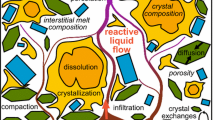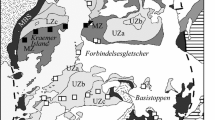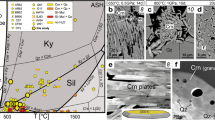Abstract
A series of calculations have been carried out to evaluate the effect on cumulus mineral compositions of solidification of trapped intercumulus liquid in orthocumulates. The calculation assumes local equilibrium between phases, and that the system remains chemically closed during crystallization of the trapped liquid. The latter assumption is held to be valid on a scale of tens to hundreds of centimeters. It is not necessary to know the composition of the trapped liquid, as the calculation only requires an estimate of FeO content and trapping temperature.
The change in composition of a mineral from that of the initially precipitated cumulus crystals to the final composition after complete solidification is termed the “trapped liquid shift”. Its magnitude depends on the modal proportions of cumulus phases and the initial porosity, and is only weakly dependent on initial phase compositions. Trapped liquid shifts are significant when compared with mineral composition changes occurring during fractional crystallization. Crystallization of 30% trapped liquid gives rise to shifts of up to 10 mol. percent in Mg number of olivine or pyroxene. The size of the shift becomes greater when the initial cumulus assemblage has a lower total FeO+MgO content, and vice versa.
As a result of the relationship between trapped liquid shift and cumulus mode, mineral composition variations and trends may be generated in sequences of cumulates which originally had constant compositions of cumulus minerals. For example, in a cyclic unit grading from a pyroxenitic base to an anorthositic top, crystallization of a uniform proportion of trapped liquid will result in an apparent iron enrichment trend from bottom to top of the cycle, as has been observed in the Upper Critical Zone of the Bushveld Complex.
Similar content being viewed by others
References
Arndt NT (1977) Partitioning of nickel between olivine and ultra-basic and basic komatiite liquids. Carnegie Inst Yearbook 76:553–557
Barnes SJ (1985) Experimental determination of partition coefficients for Cr between orthopyroxene and a synthetic Bushveld/ Stillwater parent melt as a function of oxygen fugacity and temperature: implications for the distribution of chromite in layered intrusions. Lunar Planet Sci XVI
Barnes SJ, Naldrett AJ (1986) Geochemistry of the J-M (Howland) Reef of the Stillwater Complex, Minneapolis Adit area. II. Silicate mineral chemistry and petrogenesis. J Petrol
Cameron EN (1982) The Upper Critical Zone of the Eastern Bush-veld Complex — Precursor of the Merensky Reef. Econ Geol 77:1307–1327
Campbell IH (1978) Some problems with the cumulus theory. Lithos 11:311–323
Campbell IH (1986) The distribution of orthocumulate textures in the Jimberlana intrusion: implications for the efficiency of fractional crystallization. J Geol
Cawthorne RG (1982) An origin for the small scale fluctuations in orthopyroxene composition in the lower and critical zones of the Bushveld Complex, South Africa. Chem Geol 36:227–236
Cawthorne RG, Davies G (1983) Experimental data at 3 kbars pressure on parental magma to the Bushveld Complex. Contrib Mineral Petrol 83:128–135
Chalokwu CI, Grant NK (1983) The importance of trapped liquid abundances to the re-equilibration of primary mineral compositions in the Partridge River troctolite, Duluth Complex, Minnesota. Geol Soc Amer Abstracts with Prog 15:541
Duke JM, Naldrett AJ (1978) A numerical model of the fractionation of olivine and molten sulphide from komatiite magma. Earth Planet Sci Lett 39:255–266
Gain SB (1985) The geologic setting of the Platiniferous UG-2 Chromitite layer on the Farm Maandagshoek, Eastern Bush-veld Complex. Econ Geol 80:925–943
Grant NK, Moiling PA (1981) A strontium isotope and trace element profile through the Partridge River tractolite, Duluth Complex, Minnesota. Contrib Mineral Petrol 77:296–305
Henderson P (1968) The distribution of phosphorus in the early and middle stages of fractionation of some basic layered intrusions. Geochim Cosmochim Acta 32:897–911
Henderson P (1970) The significance of the mesostasis of basic layered igneous rocks. J Petrol 11:463–473
Irvine TN (1980) Magmatic infiltration metasomatism, double diffusive fractional crystallisation and adcumulus growth in the Muskox Intrusion and other layered intrusions. In: Hargraves RB (ed) Physics of magmatic processes. Princeton Univ, Princeton, p 325–383
Irvine TN (1982) Terminology for layered intrusions. J Petrol 23:127–162
Jackson ED (1961) Primary textures and mineral associations in the ultramafic zone of the Stillwater Complex, Montana. Geol Soc Amer Prof Paper 358:106pp
Kruger FJ, Marsh JS (1985) The mineralogy, petrology and origin of the Merensky cyclic unit in the Western Bushveld Complex. Econ Geol 80:958–974
Lightfoot PC, Naldrett AJ, Hawkesworth CJ (1984) The geology and geochemistry of the Waterfall Gorge Section of the Insizwa Complex with particular reference to the origin of the nickel sulfide deposits. Econ Geol 79:1857–1879
Loney RA, Himmelberg GR (1983) Structure and petrology of the La Perouse Gabbro Intrusion, Fairweather Range, South-eastern Alaska. J Petrol 24:377–423
Longhi J (1982) Effects of fractional crystallization and cumulus processes on mineral composition trends of some lunar and terrestrial rock series. Proc Lunar Planet Sci 13th, J Geophys Res 87:A54-A64
McBirney AR, Noyes RM (1979) Crystallisation and layering of the Skaergaard Intrusion. J Petrol 20:487–554
Naldrett AJ, Gasparrini C, Barnes SJ, von Gruenewaldt G, Sharpe MR (1982) Cyclic variations in the Upper Critical Zone of the Bushveld Complex and its implications as to the origin of the Merensky Reef: a progress report. Geol Ass Canada, Mineral Ass Canada Prog with Abstracts 7:69
Nielsen RL, Drake MJ (1979) Pyroxene — melt equilibria. Geochim Cosmochim Acta 43:1259–1272
Raedeke LD, McCallum IS (1980) A comparison of fractionation trends in the lunar crust and the Stillwater Complex. In: Papike JJ, Merrill RB (eds), Proc Conf Lunar Highlands Crust, p 133–153
Raedeke LD, McCallum IS (1984) Investigations in the Stillwater Complex, part. II. Petrology and petrogenesis of the ultramafic series. J Petrol 25:395–420
Roeder PL, Emslie RF (1970) Olivine — liquid equilibrium. Contrib Mineral Petrol 29:275–289
Sack RO (1980) Some constraints on the thermodynamic mixing properties of Fe-Mg orthopyroxenes and olivines. Contrib Mineral Petrol 71:257–269
Salpas PA, Haskin LA, McCallum IS (1983) Stillwater anortho-sites: a lunar analog? Proc Lunar Planet Sci Conf 14th, J Geophys Res 88 Suppl:B27-B39
Salpas PA, Haskin LA, McCallum IS (1984) The scale of compositional heterogeneities in Stillwater anorthosites An-I and An-II. Lunar Planet Sci XV:713–714
Sampson E (1969) Discussion: Stillwater, Montana Chromite Papers. Econ Geol Monograph 4:72–76
Tait SR, Huppert HE, Sparks RSJ (1984) The role of compositional convection in the formation of adcumulate rocks. Lithos 17:139–146
Wager LR (1963) The mechanism of adcumulus growth in the layered series of the Skaergaard intrusion. Mineral Soc Amer Spec Paper 1:1–9
Wager LR, Brown GM (1968) Layered igneous rocks. Oliver & Boyd, Edinburgh, 588pp
Wilson AH (1982) The geology of the Great ‘Dyke’, Zimbabwe: the ultramafic rocks. J Petrol 23:240–292
Author information
Authors and Affiliations
Rights and permissions
About this article
Cite this article
Barnes, S.J. The effect of trapped liquid crystallization on cumulus mineral compositions in layered intrusions. Contr. Mineral. and Petrol. 93, 524–531 (1986). https://doi.org/10.1007/BF00371722
Received:
Accepted:
Issue Date:
DOI: https://doi.org/10.1007/BF00371722




